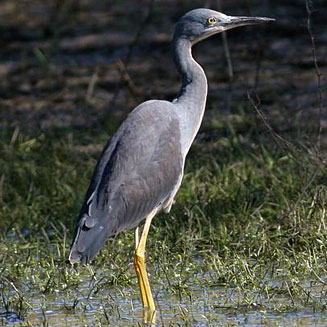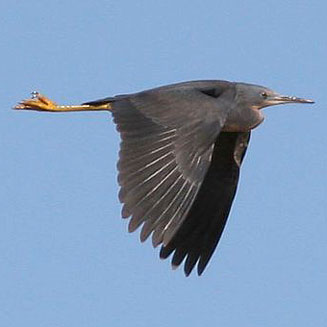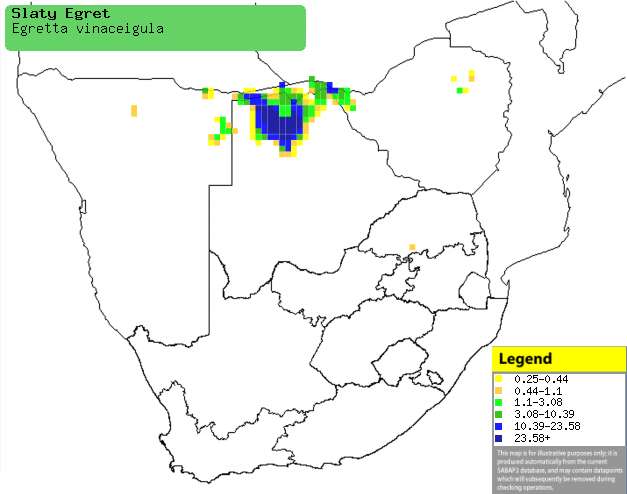|
Egretta vinaceigula (Slaty
egret)
Rooikeelreier [Afrikaans]; Samunkoma (also applied to other
long-neck egrets and herons) [Kwangali]; Sharpe-reiger [Dutch]; Aigrette
vineuse [French]; Braunkehlreiher, Schieferreiher [German];
Garça-de-garganta-vermelha [Portuguese]
Life
> Eukaryotes >
Opisthokonta
> Metazoa (animals) >
Bilateria >
Deuterostomia > Chordata >
Craniata > Vertebrata (vertebrates) > Gnathostomata (jawed
vertebrates) > Teleostomi (teleost fish) > Osteichthyes (bony fish) > Class:
Sarcopterygii (lobe-finned
fish) > Stegocephalia (terrestrial
vertebrates) > Tetrapoda
(four-legged vertebrates) > Reptiliomorpha > Amniota >
Reptilia (reptiles) >
Romeriida > Diapsida > Archosauromorpha > Archosauria >
Dinosauria
(dinosaurs) > Saurischia > Theropoda (bipedal predatory dinosaurs) >
Coelurosauria > Maniraptora > Aves
(birds) > Order: Ciconiiformes
> Family: Ardeidae
 |
 |
| Slaty egret (immature), Niewoudtville,
South Africa. [photo Trevor Hardaker ©] |
Slaty egret (immature), Niewoudtville, South
Africa. [photo Trevor Hardaker ©] |
Distribution and habitat
Endemic to south-central Africa, occurring from Zambia and
south-eastern Angola to northern Botswana, the Caprivi Strip (Namibia), north-western and northern Zimbabwe and
southern Limpopo Province. It generally favours the shallow margins of wetlands, sometimes
moving into temporary wetlands in otherwise arid areas.
|
 |
|
Distribution of Slaty egret in southern Africa,
based on statistical smoothing of the records from first SA Bird Atlas
Project (©
Animal Demography unit, University of
Cape Town; smoothing by Birgit Erni and Francesca Little). Colours range
from dark blue (most common) through to yellow (least common).
See here for the latest distribution
from the SABAP2. |
Predators and parasites
- Predators of eggs and chicks
Movements and migrations
Mainly resident in large, perennial wetlands,
although in summer rains it may make movements to ephemeral water
bodies and flood plains.
Food
It mostly eats fish, tadpoles and aquatic insects, doing
most of its foraging in shallow water with emergent grasses or sedges, wading
quickly and chasing down prey (which it regularly flushes by stirring its feet).
It often joins mixed-species foraging flocks along with
storks and other
herons. The following food items have been recorded
in its diet:
- fish
- tadpoles
- invertebrates
- dragonflies and their larvae (Odonata)
- snails
Breeding
- Usually breeds in mixed-species colonies along with
Dwarf bitterns,
Rufous-bellied herons or even
Red-billed buffalo-weavers.
- The nest is a platform of twigs with a central depression, lined with
reeds or grass and typically placed in a bush over water, such as a Water fig (Ficus
verruculosa) or Acacia kirkii (Flood-plain acacia), or
alternatively in a reedbed.
- Egg-laying season is from February-May, peaking in March.
- It lays 2-4 eggs, which are incubated for 21-24 days.
- The chicks start to move around close to the nest after a week or so,
leaving completely at about 40 days old, at which point they perch on trees
nearby.
Threats
Globally Vulnerable, although it is more likely to
be endangered, as swamp burning and reed-cutting are severely impacting it.
Disturbance by humans and livestock at temporary pans and rivers is also a
serious concern.
References
-
Hockey PAR, Dean WRJ and Ryan PG 2005. Roberts
- Birds of southern Africa, VIIth ed. The Trustees of the John Voelcker
Bird Book Fund, Cape Town.
|
